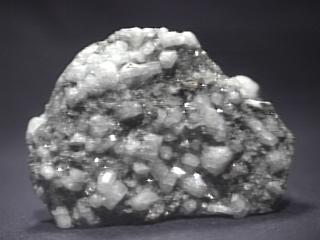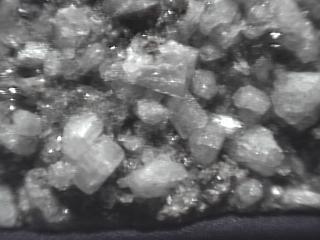 THE MINERAL HARMOTOME
THE MINERAL HARMOTOME
- Chemistry: BaAl2Si6O16 - 6H2O, Hydrated barium aluminum silicate.
- Class: Silicates
- Subclass: Tectosilicates
- Group: Zeolites
- Uses: Mineral specimen and chemical filter.
Specimens
Harmotome is occasionally found with other zeolites like heulandite and stilbite in the typical zeolite occurrence inside of vesicles or bubbles of volcanic rocks. However it is one of the only zeolites to be found in ore deposits.
Phillipsite is another zeolite that is difficult to distinguish from harmotome. It to commonly forms twins and in fact can form nearly the same twin as harmotome, although less likely to do so. The slightly less dense phillipsite is more likely to be found as aggregates and not as individual twinned crystals and is never found in ore deposits.
Zeolites have an openness about their structure that allows large ions and molecules to reside and actually move around inside the overall framework. The structure actually contains open channels that allow water and large ions to travel into and out of the crystal structure. The size of these channels controls the size of the molecules or ions and therefore a zeolite like harmotome can act as a chemical sieve, allowing some ions to pass through while blocking others.
PHYSICAL CHARACTERISTICS:
- Color is colorless, white and yellowish.
- Luster is vitreous.
- Transparency: Crystals are transparent to translucent, often milky.
- Crystal System is monoclinic; 2/m
- Crystal Habits include a classic penetration twinned crystal that is seemingly composed of three prismatic crystals growing through each other at near 90 degree angles. Although examples showing a perfectly formed twin crystal are scarce, twinning is wide spread and almost all crystals of harmotome are twinned. Aggregates can be radiating and columnar.
- Cleavage is poor in one direction.
- Fracture is conchoidal to uneven.
- Hardness is 4.5.
- Specific Gravity is approximately 2.4 - 2.5 (light, but heavier than most zeolites).
- Streak is white.
- Associated Minerals are
quartz,
heulandite,
stilbite,
pyrite,
brewsterite , edingtonite, barite and other barium and some manganese minerals. - Notable Occurrences include several localities in Germany also found at Kongsberg, Norway; Strontian, Highland, Scotland; Wales, Westchester Co., New York, USA and in other localities around the world.
- Best Field Indicators are crystal habit, twinning, density, hardness and associations.



